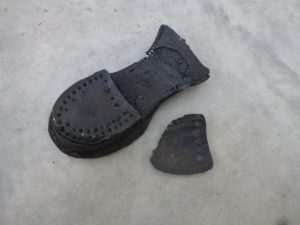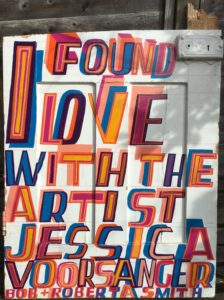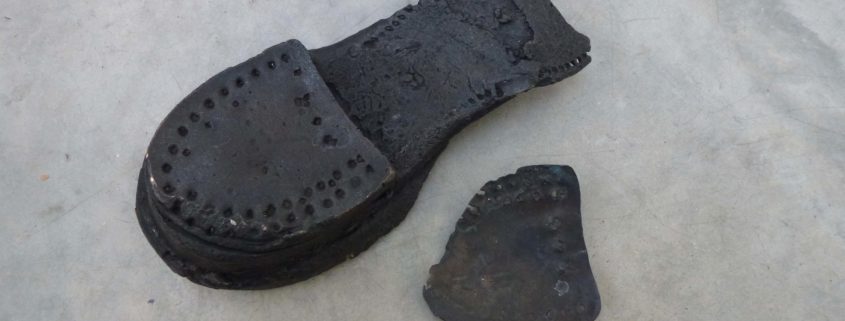FOUND: One inspiring collaboration by Caro Howell
I recently read a blog comment about our current exhibition FOUND, which questioned whether the ‘inserting of contemporary art in among the traditional stuff [is] becoming a rather annoying cliche?’ . It made me wonder why, if we enjoy seeing living artists responding to the art of the past within their own work, should seeing this creative conversation writ large be a cliché? Personally, I love discovering what intrigues intriguing people; to see the familiar afresh through their eyes, or to be introduced to the unfamiliar through their enthusiasm. This is particularly true when it comes to artists, as they have an uncanny ability to notice things that otherwise go overlooked.
The Foundling Museum is an unusual art museum because our collection is freighted with anecdote and emotion, making it hard to contemplate the artworks in formal terms alone. This is because the majority of the paintings, sculptures, ceramics, scores, furniture and interiors on display were given by their creators in support of the Foundling Hospital, which was set up in 1839 to care for babies at risk of abandonment. Led by artist William Hogarth and composer George Frideric Handel, painters, sculptors, craftsmen and musicians donated their professional skills in order to generate public interest and donations. In the process they established the UK’s first public art gallery, sowed the seed for the founding of the Royal Academy, and helped secure the Hospital’s future, so much so that it continues today as the children’s charity Coram.
Shown alongside the artwork s are archival objects that speak to the lives of the 25,000 children who grew up at the Hospital between the 1740s and 1950s. Amongst these are the eighteenth-century ‘tokens’, small objects left by mothers with their babies as a means of identification should they return to reclaim their child. The majority of the tokens are ‘found objects’ and reflect the everyday lives of ordinary Londoners, from coins, buttons, tickets and playing cards, to something as abject as a nut. It is the collision of the quotidian with the esoteric and individual loss within history’s anonymous sweep that visitors find so moving. In addition, because our story concerns childhood and the power of collective action, the Museum is permeated by a sense of shared experience.
s are archival objects that speak to the lives of the 25,000 children who grew up at the Hospital between the 1740s and 1950s. Amongst these are the eighteenth-century ‘tokens’, small objects left by mothers with their babies as a means of identification should they return to reclaim their child. The majority of the tokens are ‘found objects’ and reflect the everyday lives of ordinary Londoners, from coins, buttons, tickets and playing cards, to something as abject as a nut. It is the collision of the quotidian with the esoteric and individual loss within history’s anonymous sweep that visitors find so moving. In addition, because our story concerns childhood and the power of collective action, the Museum is permeated by a sense of shared experience.
It is in this context that we asked the artist Cornelia Parker to be our Hogarth Fellow and to collaborate with us on a project of her choosing. Parker is known for her work with found objects and her ability to release their latent emotional and psychological qualities through a combination of relocation, transformation and destruction. Not surprisingly, Parker was drawn to the mothers’ tokens. She liked that as objects they had had a past life, had been co-opted, and had become emotional proxies. As an admirer of Hogarth and as a Royal Academician herself, Parker was also intrigued by Hogarth’s role in the Academy’s foundation, and appreciated the way he’d used contemporary art to lure unsuspecting audiences to the Foundling Hospital in order to gain support for the charity’s work.
After a year of visiting the Museum and talking to the curatorial team, Parker proposed curating an exhibition. Her idea was deceptively simple: artists, writers and musicians would be asked to respond to the theme of ‘found’ with a new or existing work, or a found object of significance to them. In Parker’s words ‘In order for something to be found, it must first be lost.’
Drawing on friends and past collaborators, Parker assembled a group of 69 participants, including 21 Royal Academicians,  who in turn contributed 99 objects and works for display. The plan had always been to move beyond the temporary exhibition gallery and to show elements throughout the Museum. However, once we saw people’s contributions it was clear that to do otherwise would be perverse. We were continually amazed at the parallels and quiet conversations that different objects generated with their historic roommates. Humphrey Ocean’s gleaming chrome hubcap hides in plain sight amongst the silverware, a nod to our deification of the motor car. Ron Arad’s 2.5 metre long string of pawn broker’s coupons from 1951, many with ‘GWR’ meaning gold wedding ring, hangs near to the Hospital’s admission receipts, another testament to the impact of financial hardship on family life. A new animation by Christian Marclay documenting hundreds of discarded bottle caps precedes a case of tokens, while lying in the Court Room – the ornate Rococo space in which the Governors met to decide which mothers would be helped and which babies admitted – is Gavin Turk’s Nomad, 2002, a life-size painted bronze of a homeless person curled up in a sleeping bag.
who in turn contributed 99 objects and works for display. The plan had always been to move beyond the temporary exhibition gallery and to show elements throughout the Museum. However, once we saw people’s contributions it was clear that to do otherwise would be perverse. We were continually amazed at the parallels and quiet conversations that different objects generated with their historic roommates. Humphrey Ocean’s gleaming chrome hubcap hides in plain sight amongst the silverware, a nod to our deification of the motor car. Ron Arad’s 2.5 metre long string of pawn broker’s coupons from 1951, many with ‘GWR’ meaning gold wedding ring, hangs near to the Hospital’s admission receipts, another testament to the impact of financial hardship on family life. A new animation by Christian Marclay documenting hundreds of discarded bottle caps precedes a case of tokens, while lying in the Court Room – the ornate Rococo space in which the Governors met to decide which mothers would be helped and which babies admitted – is Gavin Turk’s Nomad, 2002, a life-size painted bronze of a homeless person curled up in a sleeping bag.
FOUND has been open for three weeks and people are coming in large numbers to see and join these creative conversations. Like Hogarth, Cornelia Parker is drawing a new audience to the Museum, but at the same time regular visitors say they’re noticing aspects of the Collection they had previously overlooked. Most importantly, visitors’ written comments reveal an appreciation for the way that Parker has highlighted what they instinctively knew; that the story the Foundling Museum tells is always contemporary and urgent, and artists lie at its heart.
So in response to that blog comment I would say that the success of any creative endeavour depends on the strength and integrity of the idea. If you have the right artist working with the right ‘traditional stuff’, the result can be inspired, inspiring and magical.
The Foundling Museum invites Knowledge Quarter partners to a morning private view of the exhibition from 9.00 to 10.00 on 20 of July 2016. Please RSVP to reserve you place.
Please click here for more info on the exhibition.


